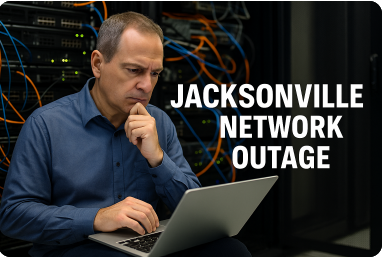1. Introduction
In September 2024, the City of Jacksonville, Florida, experienced a major technical disruption that significantly impacted its digital infrastructure. Referred to widely as the Jacksonville computer network issue, this incident brought many essential municipal services to a standstill.
Unlike typical cybersecurity attacks, this disruption stemmed from internal hardware failures, exposing the vulnerabilities in the city’s IT infrastructure and prompting city officials and federal agencies to launch a swift response.
This incident highlighted the vital role of technology in ensuring continuous public services and demonstrated the need for robust digital preparedness.
2. Timeline of Events
The Jacksonville computer network issue unfolded over several days in mid-September. Here’s a chronological look at how the situation developed:
| Date | Event |
|---|---|
| September 11 | Initial reports of website and network slowdowns surface. |
| September 12 | Multiple city systems go offline, affecting public access and services. |
| September 13 | City identifies a hardware failure as the root cause of the problem. |
| September 14–17 | Restoration efforts continue; city websites begin coming back online. |
| September 18 | Most services return to operational status; monitoring remains ongoing. |
Throughout this period, the disruption affected not only digital services but also led to delays and inconvenience for both citizens and city employees.
3. Affected Services and Departments
The extent of the Jacksonville computer network issue became more apparent as various city departments reported service outages and performance slowdowns. Key services impacted included:
- Public Websites: Official city websites like Jacksonville.gov and JaxReady.com were inaccessible, cutting off a critical source of information.
- Customer Support: The 630-CITY helpline, a primary communication channel for city services, was down, leaving citizens unable to report issues or get updates.
- Mobile Applications: Important mobile apps used for municipal tasks and emergency alerts were rendered inoperable.
- City Departments: Several departments, such as the Duval County Tax Collector’s Office, the Public Defender’s Office, and the Clerk of Court, experienced delays in their day-to-day operations.
- Emergency Services: While the Jacksonville Fire and Rescue Department (JFRD) maintained functionality, they noted longer processing times for certain systems.
This widespread impact showed just how dependent modern governance is on digital tools and reliable IT infrastructure.
4. Root Causes of the Disruption
The city confirmed that the Jacksonville computer network issue was not the result of a cyberattack. Instead, a significant hardware failure led to the network outage. Investigations revealed that aging IT infrastructure and insufficient redundancy mechanisms allowed a single point of failure to compromise multiple systems.
Key Contributing Factors:
- Outdated Hardware: Core servers and switches had not been updated or replaced on a regular schedule.
- No Failover Systems: The city lacked adequate backup systems to handle unexpected downtime.
- Environmental Wear: Heat and humidity over time had contributed to the degradation of physical components housed in older server rooms.
This failure emphasized the importance of preventive maintenance and investment in modern infrastructure.
5. Impact on City Operations
The Jacksonville computer network issue disrupted both internal and public-facing city operations. Employees in multiple departments had to resort to manual processes, such as handwritten forms and in-person data collection, which slowed down workflows dramatically.
Consequences Included:
- Service Delays: Processing times for permits, court documents, and public records were significantly increased.
- Operational Bottlenecks: Departments like JFRD faced delays in accessing real-time data and dispatch systems.
- Financial Impacts: City revenue collection was delayed due to downtime in tax and payment systems.
- Public Frustration: Citizens expressed dissatisfaction with the inability to access basic services online.
The disruption posed a serious challenge to maintaining normal government operations, underscoring how essential technology has become to efficient service delivery.
6. Emergency Response and Recovery Efforts
Once the problem was identified, Jacksonville officials activated their Emergency Operations Center (EOC) to manage the crisis. The city worked closely with federal partners, including the FBI and the Department of Homeland Security, to ensure that the problem was not security-related and to accelerate recovery efforts.
Response Measures Taken:
- Deployment of city IT personnel for round-the-clock monitoring.
- Federal support teams provided additional diagnostic tools and technical expertise.
- External vendors were brought in to assist with hardware replacement and restoration.
- Public updates were issued to manage expectations and inform residents.
The coordinated response helped restore most services within a week, although full operational stability took longer to achieve.
7. Public Communication and Transparency
One of the commendable aspects of how the Jacksonville computer network issue was handled was the city’s approach to transparency. From the outset, officials assured the public that there was no data breach or cybersecurity incident.
The mayor’s office released regular updates, both via media briefings and social media, to keep residents informed about restoration progress.
This level of openness helped maintain public trust and demonstrated the importance of timely, accurate communication during technology failures.
8. Lessons Learned and Future Preparedness
The Jacksonville computer network issue served as a wake-up call for the city’s IT department and policymakers. Several key lessons emerged from the experience, all pointing toward the need for modernization and proactive risk management.
Key Takeaways:
- Modernization of IT Infrastructure: The city is now investing in new hardware and software systems with built-in redundancy.
- Regular Maintenance: Scheduled reviews and hardware health checks have been mandated.
- Contingency Planning: Emergency response protocols have been revised to include scenarios involving tech failures.
- Cybersecurity and Hardware Segmentation: While this wasn’t a breach, the city plans to segment critical systems to minimize risk in the future.
- Staff Training: Employees will receive additional training to handle manual operations during outages.
| Future Improvements | Expected Benefits |
|---|---|
| Infrastructure Upgrades | Greater reliability and faster system recovery |
| Backup System Integration | Reduced downtime during future disruptions |
| Staff Digital Literacy | Improved efficiency in emergency scenarios |
| Enhanced Monitoring Tools | Early detection of potential system failures |
These steps aim to protect not only the city’s infrastructure but also the quality of service delivered to its residents.
9. Conclusion
The Jacksonville computer network issue of September 2024 was a significant event that exposed the fragility of outdated municipal IT systems. While not malicious in nature, the disruption served as a powerful reminder that system resilience requires continual investment, modernization, and strategic planning.
Thanks to swift action by city officials and federal partners, most services were restored promptly, and measures are now in place to avoid similar incidents in the future.
10. Frequently Asked Questions (FAQs)
Q: What caused the Jacksonville computer network issue?
A: The issue was caused by a critical hardware failure, not a cyberattack. Aging infrastructure and lack of system redundancy were key contributing factors.
Q: Were emergency services like fire and rescue impacted?
A: While operational, emergency services did face longer processing times and had to work with limited digital tools.
Q: What is being done to prevent such issues in the future?
A: The city is upgrading its IT infrastructure, implementing redundancy, and improving emergency response protocols.
Q: Was any personal data leaked or compromised?
A: No. Officials confirmed that there was no breach of data or cybersecurity compromise.
Related Articles
Discover MU88 Elysii: A Comprehensive Guide to the Next-Gen Gaming Platform
Discover the World of OrannaLaura: Fashion, Innovation, and Holistic Living
Ceylan Eye Cream Reviews: Detailed Guide, Ingredients, Benefits, and User Feedback
🎰 Vanessa-Casino.com 8002662278 – Honest Review, Contact Info & What You Need to Know

